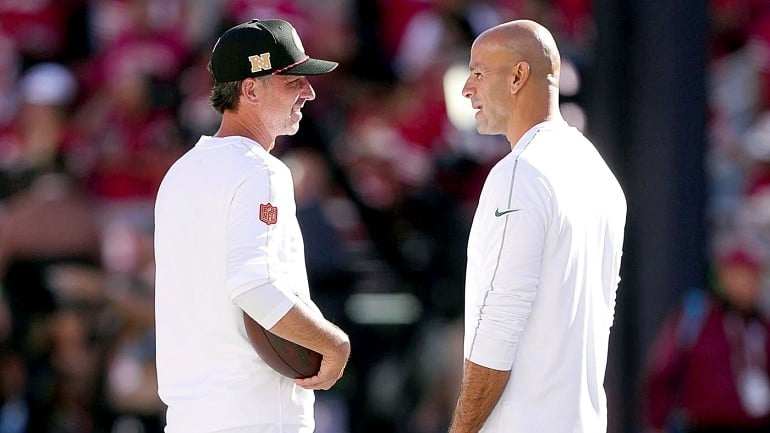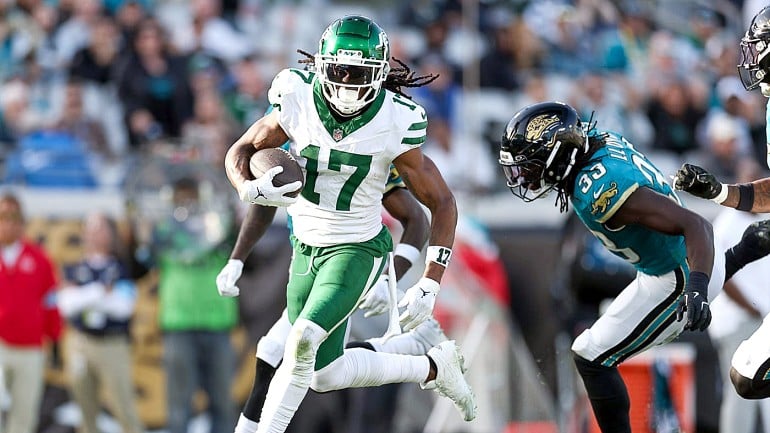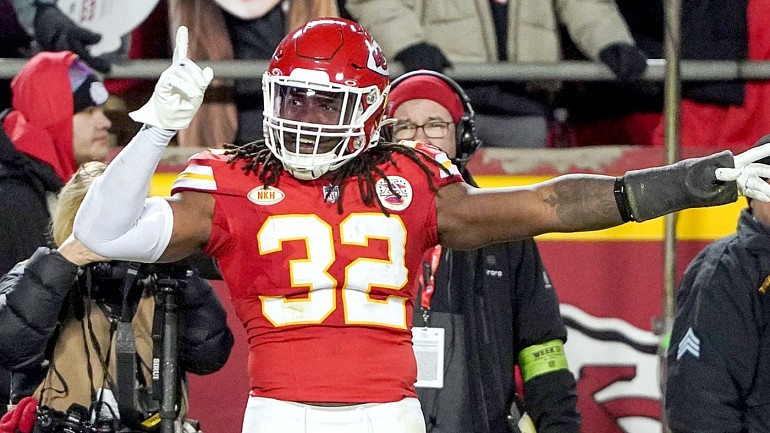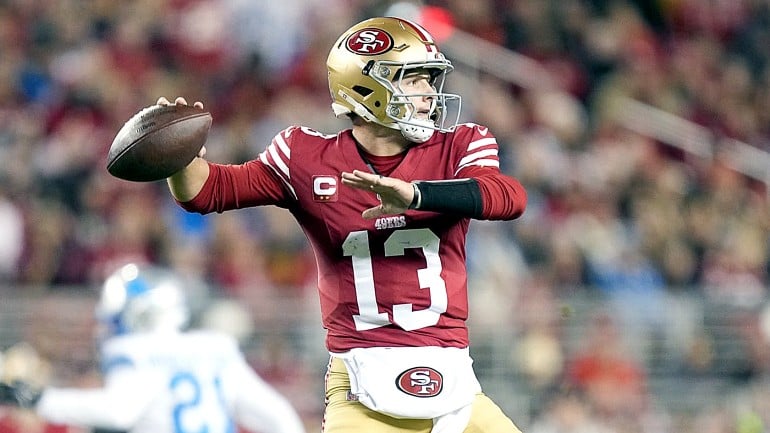This is the first part of a two-series on running back Jerick McKinnon and his potential fit in the 49ers offense. The first part examines his ability in the running game. Part two will examine his role in the passing game.
The 49ers signed running back Jerick McKinnon to a four-year contract this offseason after electing to not re-sign Carlos Hyde. The deal surprised a number of people, especially the initial contract number, as it didn't appear to align with how head coach Kyle Shanahan views the running back position. The Shanahans are known for taking running back talent late in the draft (Terrell Davis/Alfred Morris) or undrafted (Matt Breida) and getting top production out of it (Breida was eighth in total yards in the rookie running back class of 2017 and third in yards per carry behind Leonard Fournette and Alvin Kamara). However, we know what Kyle Shanahan wants in a running back and McKinnon fits that role quite nicely, so much so that the team got into a bidding war for the running back.
In 2017 during OTAs, Shanahan said of the running back position:
Well, we go pretty hard and there's guys who play their gaps. You want to see, there's an art to hitting the right gap and running full speed and going to where the guy and the defense is out of position. I always joke with the backs, I can see it every time when I have a remote in my hand and it's very slow and I can be, 'Oh, you should have gone there.' No one plays running back with a remote in their hand. They just run and it comes natural. So, you try to see who naturally runs to the right spots and there's guys who aren't the most flashy running backs to the naked eye, but for some reason they have better yards-per-carry than everyone else does and that's because they get to the right hole and it's always four yards, six yards in. Whatever the defense, whatever the offense blocks it for they usually get two more. We try to see who the most natural runners are, who it's not too big for and their conditioning and how hard they go.
Fans familiar with my writings may also remember that the running back is the life-blood of the 49ers offense, as I detailed here before the 2017 season:
In 2017, the 49ers will predominantly be an outside zone running team, and many of the recent hires would suggest as much. First, Kyle Shanahan was undoubtedly influenced by his dad Mike Shahanan, who primarily ran the outside zone with the Broncos in the late 1990s and 2000s. The father of the modern day zone running game is Alex Gibbs, who I covered at length in an earlier post linked above. He is primarily an outside zone running game expert and was crucial to the success of the Broncos two Super Bowl championship teams. Second, the 49ers hired running backs coach Bobby Turner, who also coached under Mike Shanahan and Alex Gibbs in Denver. And lastly, the 49ers hired John Benton, who worked with Kyle Shanahan in Houston under Gary Kubiak, who also coached under Mike Shanahan in Denver. So the roots are plentiful.
Alex Gibbs is the important name here, as he outlines the running backs role in the offense, similar to what Shanahan said in the above quote:
On the third step, the running back is either going downhill or taking the ball outside. The reason the decision is made on the third step is the timing of the blocks within the offensive line. On the third step, the offensive linemen make their push on the defenders. The push of the offensive line and the cut of the back must coincide. The back does not know where the cut will be until he gets his third step on the ground. He makes his decision on that step and commits to it. Whatever decision he makes, he lives with it. He does not dodge defenders or double cut with the ball. He takes what the picture says and gets the ball upfield and outside right away.
Shanahan relies heavily on the running game to set up the pass, as was evident in his use of play-action, especially last season. But he also uses the passing game to keep a defense honest and will pass on obvious running downs or vice versa depending on how the defense counters Shanahan's use of heavy formations (21 and 22 personnel). A strong running game has enabled even mediocre quarterbacks in his system like Brian Hoyer and Matt Schaub to have semi-productive seasons. More elite quarterbacks have gone to the Super Bowl (Matt Ryan).
In 2016, the Falcons under Shanahan ran outside zone 35% of the time and in 2017, and per Pro Football Focus' Jeff Deeney, the 49ers ran outside zone 43% of the time while running the inside zone 37% of the time. The 49ers ranked 4th in total outside zone runs in the NFL with 175 behind Atlanta (214), Dallas (198), and Buffalo (187).
It's fair to assume that the addition of McKinnon behind Jimmy Garoppolo will make the 49ers offense highly competitive as McKinnon can both run and catch with equal ability. It's also a fair assessment to say that McKinnon was criminally under-utilized with his skill-set in Minnesota.
JERICK MCKINNON CAREER STATS
| Year | Age | Team | No. | G | GS | Rush | Yds | TD | Lng | Y/A | Y/G | A/G | Fmb |
| 2014 | 22 | MIN | 31 | 11 | 6 | 113 | 538 | 0 | 55 | 4.8 | 48.9 | 10.3 | 0 |
| 2015 | 23 | MIN | 31 | 16 | 0 | 52 | 271 | 2 | 68 | 5.2 | 16.9 | 3.3 | 0 |
| 2016 | 24 | MIN | 21 | 15 | 7 | 159 | 539 | 2 | 36 | 3.4 | 35.9 | 10.6 | 0 |
| 2017 | 25 | MIN | 21 | 16 | 1 | 150 | 570 | 3 | 58 | 3.8 | 35.6 | 9.4 | 3 |
| Career | 58 | 14 | 474 | 1918 | 7 | 68 | 4 | 33.1 | 8.2 |
Statistics courtesy of Pro Football Reference
For today, we'll focus only on McKinnon's skill set in the running game and hopefully see why Shanahan pursued him to be the primary back in this offense. McKinnon displays the vision and cut ability that coach Alex Gibbs outlined above and it gives McKinnon the ability to beat defenders to the edge or cut back against the grain and make defenders miss.
VISION AND CUT ABILITY
His vision and cut ability was on display early on in his career with Minnesota and two plays in particular showcase this ability.
Against the Giants, the Vikings here are running the inside zone.
By the time McKinnon takes the handoff from quarterback Teddy Bridgewater, the Giants defense has filled every playside gap, not allowing the Vikings offensive line to push them off the ball.
As McKinnon is bottled up, the backside of the defense has a slight breakdown in contain as the backside linemen gain outside leverage on the backside force defenders. With all the Giants defenders pinching their gaps, there is no help backside.
The Giants are unable to pin McKinnon in the middle of the defense as McKinnon sees the hole develop on the backside. The Vikings eventually wall-off the defense and McKinnon breaks free using his quick cut ability and speed to beat the defense for a touchdown.
A year later against the Giants, McKinnon uses his vision to turn what would appear to be a negative loss into a positive gain by unconventionally breaking away from lead blocker in a gap blocking scheme run, the power run.
On a power run, instead of relying on traditional zone blocking to open a running lane, potentially anywhere along the offensive line, the power run seeks to create a new gap by using a double-team block and a pulling lineman at the point of attack. Power has three main elements that define the scheme: 1) a double team at the point of attack, 2) a kick out block of the end man on the line of scrimmage (EMLOS, either a defensive end or an outside linebacker or safety in a 3-4) and 3) a lead block through the resulting hole.
The Giants play it patiently though and plug all their assigned gaps, bottling up the linemen and creating no running room for McKinnon.
But like the play above, the Giants again over-pursue thinking they have the offensive line sealed off and McKinnon bottled up for a loss or at least a no-gain. They again have no backside contain player and McKinnon exploits that by breaking a cardinal rule of lead blocking: that a running back is taught to follow his blockers no matter what.
WIth all their momentum crashing toward the play side, McKinnon cuts on a dime and escapes the pile of defenders and offensive lineman and cuts back against the grain across to the wide side of the field, making three defenders miss in the process before picking up 10 yards.
I have shown that McKinnon has the vision and cut ability to be effective on basic running plays up the middle, but does he show the same ability on outside runs as he does inside? Afterall, Shanahan's running game is primarily centered around the outside zone.
MCKINNON AND THE OUTSIDE ZONE
The short answer is yes, he does display both the vision and cut needed to be successful in the outside zone. But first, let's briefly cover what the outside zone is, how it's blocked, and what the running back's assignments are.
Whereas the inside zone seeks to push a defense vertically, the outside zone seeks to move a defense laterally and pin it to the inside. To accomplish this, the linemen will use a blocking technique known as the "rip and run" to either pin defenders to the inside (rip) or, if they have not reached their defender by the third step, seek to run the defender to the sideline (run). At the snap, the telltale sign of an outside zone run is the kick step to the sideline the offensive line takes.
The running back has a three-cut responsibility dictated by the movement of the offensive line. Gibbs stresses that this isn't a cutback, but rather a 1-cut and get up-field decision by the running back. The blocking and movement of the defense creates three reads for the running back: bounce, bang, bend. This is based on reading the two defenders on the end of the line of scrimmage to the play side. The landmark to make the read is the butt of the tight end.
If there is no tight end, the running back will use the ghost alignment of where the tight end would be as his landmark. Once the back gets to this landmark, he will read the end man on the line of scrimmage (EMLOS). If EMLOS No. 1 is hooked, the running back will "bounce" outside toward the sideline. If EMLOS No. 1 is outside of the landmark and No. 2 is sealed, he will "bang" between Nos. 1 and 2. If Nos. 1 and 2 are both outside the landmark, then the running back will "bend" it back inside No. 2.
Against the Bears last season, the Vikings are in 11 personnel here (one RB, one TE, three WRs) in their pre-snap alignment with the strong side of the formation set to the left. At the snap (above pic), McKinnon takes the handoff and by his third step, he already knows where he's going. The no. 1 and no. 2 EMLOS are both outside the landmark, indicating to McKinnon that he'll "bend" back up the middle.
After that third step, Gibbs says this is where the running back will begin to act on his read so that on those fourth and fifth steps, he makes that cut. In this case, with the defenders sealed inside, McKinnon "bends" up the middle for a 36-yard gain. You can see by the time McKinnon gets to his third step, the cut lane is dictated for him.
And while technically not the outside zone, he has enough versatility with his vision, cut, and speed to run a variety of plays like the toss sweep. Below is a compilation where he uses his traits to gain big chunks of yardage against players in space.
Lastly, below is a sampling of plays from 2014 through 2017 that illustrate how he uses not only his skill set in the outside zone, but other running scheme concepts as well.
2014 highlights
2015 highlights
2016 highlights
2017 highlights
The addition of Jerick McKinnon to the offense should provide the missing spark the 49ers running game has lacked since losing Frank Gore in 2014. His vision and cut ability combined with his speed will be a welcome addition to the backfield as Shanahan looks to really get the offensive running scheme going that he wants to run. In the second and final article of this series on McKinnon, we'll look at his versatility in the passing game and some of the many ways we can expect to see Shanahan get him the ball as a pass catcher.
Thanks to Pro Football Focus analysts Jeff Deeney and David Neumann for their data on the percentage of zone runs cited above.
All gifs and images courtesy of the NFL.
All statistics courtesy of Pro Football Reference unless otherwise noted.




